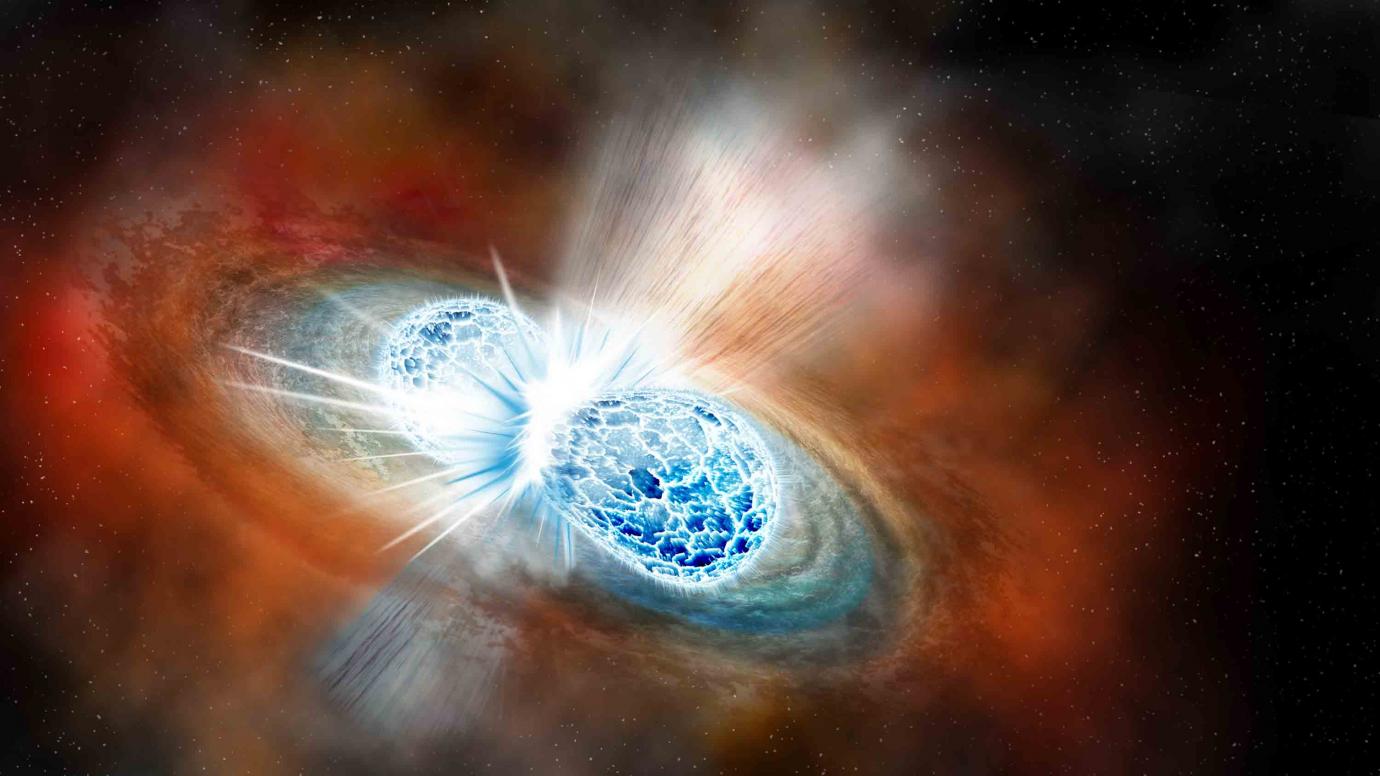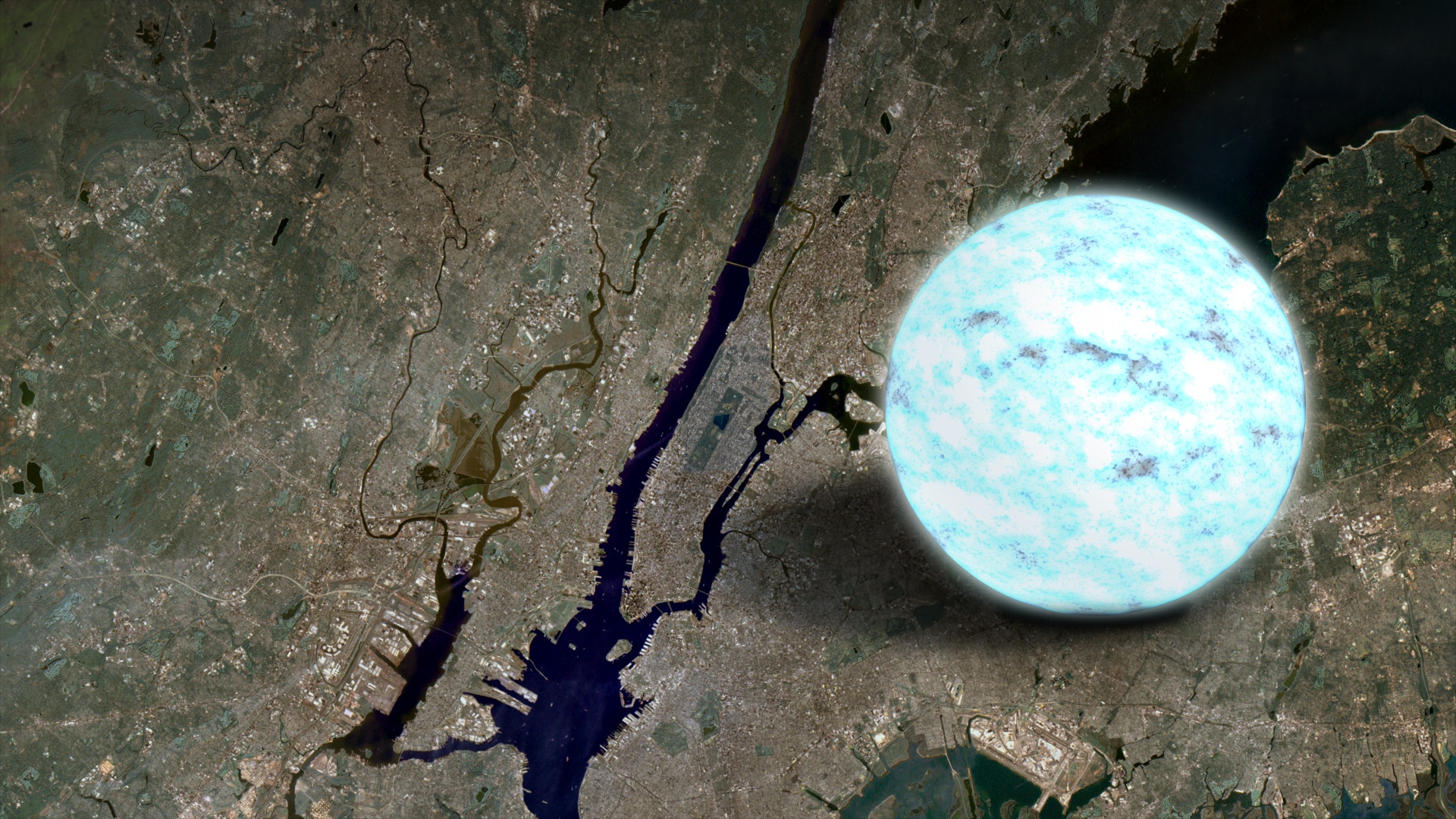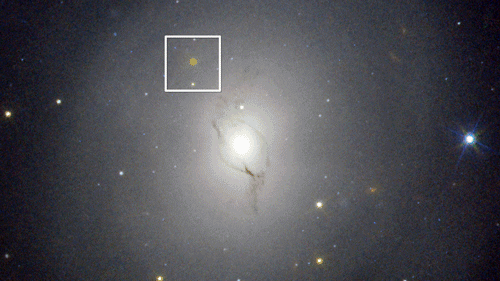
Scientists have discovered that when neutron stars collide, they leave behind a remnant that doesn't resemble either of them.
Neutron stars are the universe's most extreme stars, born when massive stars die and explode. These stars are packed with material so dense that if a teaspoon of it made its way to Earth, it would weigh 10 million tons — so, it is no wonder that, when neutron stars collide, it leads to an event of unrivaled power and violence.
This collision and merger creates the only environment in the cosmos turbulent enough to forge elements heavier than lead (like gold, silver and plutonium). Such elements can't even be created in nuclear furnaces at the hearts of the most massive stars. But the wreckage of neutron star smash-ups hides something else, too: a remnant that scientists believe should rapidly collapse to birth an entirely new black hole. A question remains. How long would this daughter ultramassive neutron star have before it becomes a black hole?
"We do not know how matter behaves at extreme densities and temperatures because such conditions cannot be realized on Earth," David Radice, an assistant professor of physics and astronomy at Pennsylvania State University, told Space.com. "Neutron star mergers are nature's super colliders and, as in particle colliders, we can learn a lot by studying the outcome of the collisions."
Searching for answers, Radice led a team of researchers that turned to supercomputers at the U.S. Department of Energy's National Energy Research Scientific Computing Center, the Leibniz Supercomputing Center in Germany, and the Institute for Computational and Data Science at Pennsylvania State University.
"The collision of two neutron stars can have two immediate outcomes. A black hole or a very massive, and possibly short-lived, hot remnant neutron star could be formed," Radice said. "Our work focuses on the latter scenario. In particular, we performed the first simulations that captured how such remnants would cool down by emitting neutrinos."
Related: Neutron star collisions could briefly trap a bunch of cosmic ghosts
The team simulated the aftermath of a neutron star collision and the interior of the neutron star remnant. The scientists then watched as tiny, almost massless "ghost particles" called "neutrinos" carried away heat from this cosmic crash scene.
A cosmic laboratory like no other
Stars essentially facilitate "cosmic tug of wars" within themselves that last for millions or billions of years. The two competitors in this contest are the outward push of energy, or "radiation pressure," generated in the nuclear furnace at the heart of a star and the inward force of the star's own gravity.
It's an epic battle, but there is only ever one winner, and that's gravity. When a massive star has forged iron at its core, as mentioned above, it can't fuse this to heavier elements, thus ending the outward surge of radiation pressure. Like an athlete celebrating by dousing their coach in Gatorade, gravity marks its victory by crushing the core of the star. This causes shockwaves that ripple through the star's outer layers, blowing them apart in a massive supernova blast.
As a result, the star loses the majority of its mass — but there are two ways this stellar corpse can go. The most massive stars, with masses over 12 times that of the sun, immediately create stellar-mass black holes. But stars with between eight and 12 times the mass of the sun birth neutron stars, a stellar remnant with a mass between one and two times that of the sun crushed into a neutron-rich body no wider than around 12 miles (20 kilometers).

About 75% of massive stars spend their lives in a binary partnership with another star. Often, when one star (usually the most massive, which burns its fuel faster) transforms into a neutron star, the supernova that results "kicks" away or destroys its stellar companion.
But, in some instances, the binary can survive this transformation, and the other massive star eventually becomes a neutron star, too. That results in a neutron star binary — but the story doesn't end there.
As these neutron stars swirl around each other, they are so massive and dense that they create ripples in the very fabric of space and time (united as a single four-dimensional entity called "spacetime") known as gravitational waves. As the gravitational waves ripple out from the binary, they carry with them angular momentum. That causes the two neutron stars to draw together, thus emitting high-frequency gravitational waves at a quickening pace. This continues until the stars finally collide and merge. Such a merger sends out a final, high-pitched "scream" of gravitational waves and sprays of matter rich in free neutrons.
These neutrons, usually found bound in atomic nuclei with protons, are ensnared by other elements around the site of the merger, a phenomenon called "the rapid capture process" or "r-process." These atoms become highly unstable, ultraheavy elements that rapidly decay into lighter elements (that are still heavier than iron). This decay causes an emission of light that astronomers call a "kilonova."
The neutron star remnant is surrounded by a rapidly spinning ring of matter called an accretion disk. This may only have a small amount of the system's mass but much of its remaining angular momentum.

The team's simulation indicated that the remains of this kind of merger are collected as a central object that contains most of the mass of the progenitor neutron stars. However, a daughter neutron star is radically different from "living stars" and even other neutron stars.
While standard neutron stars are cooler at their surfaces and hotter towards their cores, this research indicates the daughter of a neutron star merger is hotter at its surface than at its core. The scientists also found that the neutron star remnant cools predominantly via the emission of neutrinos.
"It was speculated that neutron star merger remnants would be convective, like water in a boiling pot heated from below," Radice explained. "Such convection would have brought bubbles of hot nuclear matter from the interior of the star outwards with speeds around 10% of the speed of light and produce a characteristic gravitational-wave signal that could be detected with next-generation experiments."
The simulations performed by Radice and colleagues demonstrated something different, however.
"We found, somewhat surprisingly, that all the 'cold' material sinks to the center so quickly after the merger that convection has no chance to develop," he continued. "Moreover, even though the star cools from its surface by emitting neutrinos, the neutrinos can diffuse out from the core sufficiently rapidly to prevent the surface from becoming colder than the interior, so convection cannot develop."
Radice explained that, in many ways, a neutron star merger remnant looks like a newly born neutron star in a supernova explosion. Both are extremely hot yet cool rapidly by emitting neutrinos.
"However, while newly born neutron stars are known to experience vigorous mixing, which amplifies their magnetic fields, giving birth to pulsars and magnetars, merger remnants do not do it," he added. "The remnants do not necessarily need to collapse to black hole. We do not actually know what their fate is.
"In our simulations, we have used a model for dense matter that results in a remnant that never collapses to a black hole."
While there are other models that predict immediate black hole formation or black hole formation with a short delay (with the latter scenario favored by many astronomers) Radice believes there isn't yet strong evidence one way or the other.
"We need more observations for that," he said.
This research is just the first step to understanding the physics around neutron star mergers, an environment unlike any other.
"The cleanest way to confirm or falsify our results would be to see evidence for the presence or absence of convection in the post-merger gravitational waves. Our results also suggest that there should be a delay of the order of a second between the formation of a long-lived remnant and the time it could launch a jet because we expect the magnetic field to be trapped inside the star due to the absence of convection," Radice said.
"The observation of a merger with a delayed jet launching and very blue optical counterpart, which would indicate the formation of a long-lived remnant, could also confirm our results," he said.
Now, the team intends to examine whether the force at play in the daughter neutron star created by this merger, the so-called "strong force," is strong enough to stop this remnant from collapsing to birth a black hole.
A study pertaining to these results was published late last year in The Astrophysical Journal.







